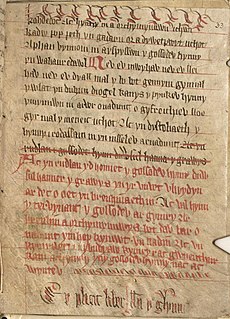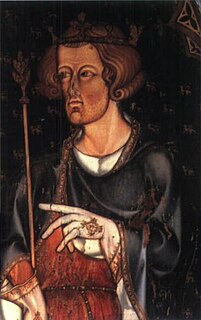| Other decades |
| 1260s | 1270s | 1280s | 1290s | 1300s |
Events from the 1280s in England .
| Other decades |
| 1260s | 1270s | 1280s | 1290s | 1300s |
Events from the 1280s in England .
The 1280s is the decade starting January 1, 1280 and ending December 31, 1289.

Llywelyn ap Gruffudd, sometimes written as Llywelyn ap Gruffydd, also known as Llywelyn the Last, was Prince of Wales from 1258 until his death at Cilmeri in 1282. The son of Gruffydd ap Llywelyn Fawr and grandson of Llywelyn the Great, he was the last sovereign prince of Wales before its conquest by Edward I of England.

The Statute of Rhuddlan, also known as the Statutes of Wales or as the Statute of Wales, provided the constitutional basis for the government of the Principality of Wales from 1284 until 1536. The Statute introduced English common law to Wales, but also permitted the continuance of Welsh legal practices within the Principality. The Statute was superseded by the Laws in Wales Acts 1535 and 1542 when Henry VIII made Wales unequivocally part of the "realm of England".

The Kingdom of Gwynedd was a Roman Empire successor state that emerged in sub-Roman Britain in the 5th century during the Anglo-Saxon settlement of Britain.

The Principality of Wales existed between 1216 and 1536, encompassing two-thirds of modern Wales during its height between 1267 and 1277. For most of its history it was ’annexed and united’ to the English Crown except for its earliest few decades. However, for a few generations, specifically the period from its foundation in 1216 to the completion of the conquest of Wales by Edward I in 1284, it was de facto independent under a Welsh prince of Wales, albeit one who swore fealty to the king of England.

Powys Fadog was the northern portion of the former princely realm of Powys, which split in two following the death of Madog ap Maredudd in 1160. The realm was divided under Welsh law, with Madog's nephew Owain Cyfeiliog inheriting the south and his son Gruffydd Maelor I, who inherited the north.

Powys Wenwynwyn or Powys Cyfeiliog was a Welsh kingdom which existed during the high Middle Ages. The realm was the southern portion of the former princely state of Powys which split following the death of Madog ap Maredudd of Powys in 1160: the northern portion (Maelor) went to Gruffydd Maelor and eventually became known as Powys Fadog; while the southern portion (Cyfeiliog) going to Owain Cyfeiliog and becoming known, eventually, as Powys Wenwynwyn after Prince Gwenwynwyn ab Owain, its second ruler.
Gruffydd ap Gwenwynwyn was a Welsh king who was lord of the part of Powys known as Powys Wenwynwyn and sided with Edward I in his conquest of Wales of 1277 to 1283.

Rhuddlan Castle is a castle located in Rhuddlan, Denbighshire, Wales. It was erected by Edward I in 1277, following the First Welsh War.
Perfeddwlad or Y Berfeddwlad was an historic name for the territories in Wales lying between the River Conwy and the River Dee. comprising the cantrefi of Rhos, Rhufoniog, Dyffryn Clwyd and Tegeingl. Perfeddwlad thus was also known as the Four Cantrefs.

Wales in the Late Middle Ages covers the period from the death of Llywelyn ap Gruffudd in late 1282 to the incorporation of Wales into the Kingdom of England by the Laws in Wales Acts 1535-1542.
Events from the 1320s in England.
This article is about the particular significance of the century 1301–1400 to Wales and its people.
This article is about the particular significance of the century 1201–1300 to Wales and its people.

The history of Gwynedd in the High Middle Ages is a period in the History of Wales spanning the 11th through the 13th centuries. Gwynedd, located in the north of Wales, eventually became the most dominant of Welsh kingdoms during this period. Distinctive achievements in Gwynedd include further development of Medieval Welsh literature, particularly poets known as the Beirdd y Tywysogion associated with the court of Gwynedd; the reformation of bardic schools; and the continued development of Cyfraith Hywel. All three of these further contributed to the development of a Welsh national identity in the face of Anglo-Norman encroachment of Wales.

Dafydd ap Gruffydd was Prince of Wales from 11 December 1282 until his execution on 3 October 1283 on the orders of King Edward I of England. He was the last independent ruler of Wales.
The Justiciar of South Wales, sometimes referred to as the Justiciar of West Wales was a royal official of the Principality of Wales during the medieval period. He controlled the southern half of the principality.

The conquest of Wales by Edward I, sometimes referred to as the Edwardian Conquest of Wales, to distinguish it from the earlier Norman conquest of Wales, took place between 1277 and 1283. It resulted in the defeat and annexation of the Principality of Wales, and the other last remaining independent Welsh principalities, by Edward I, King of England.
Baron of Hendwr, in the County of Merioneth, is a dormant title in the English Baronage which was granted on 22 July 1284 to Dafydd ap Gruffydd ap Owain Brogyntyn by letters patent issued by Edward I at Caenarfon. Dafydd and his kinsmen had fought against Edward I during his Conquest of Wales and, after coming into the King's Peace, received a Royal pardon and had their lands confirmed per Baroniam. The second Baron was summoned to Quo Warranto proceedings on 7 Dec 1334 at Harlech to assess by what authority he claimed his title and he cited the charter granted to his father in 1284. The daughter of the 3rd Baron, Gwerful ferch Madog was the wife of Goronwy ap Tudur, and therefore 3rd great-grandmother of King Henry VII. The 4th Baron, David de Hendwr married Sibella de Cornwall, daughter and heriess of John de Cornwall, great-grandson of Richard 1st Earl of Cornwall on 8 July 1343 at Westminster Abbey.
Sir Gruffydd Llywd, or Gruffydd ap Rhyd ap Gruffydd ap Ednyfed was a Welsh nobleman notable for his involvement in quashing Roger Mortimer’s 1322 revolt against King Edward II. Throughout his life until his death in 1335, Llwyd held high-ranking positions in Welsh society, with Lordships in Tregarnedd and Dinorwig and serving as Sheriff of Caernarfonshire, Anglesey and Merionethshire. Son of loyalist Rhys ap Gruffyd, Gruffyd Llwyd was a supporter of King Edward I and King Edward II, helping to enforce conformity to English rule along the Welsh Marches. Historical folklore has often mistakenly portrayed Llwyd as a ‘Welsh Rebel’ who challenged King Edward II, though this has been strongly disputed by historians.